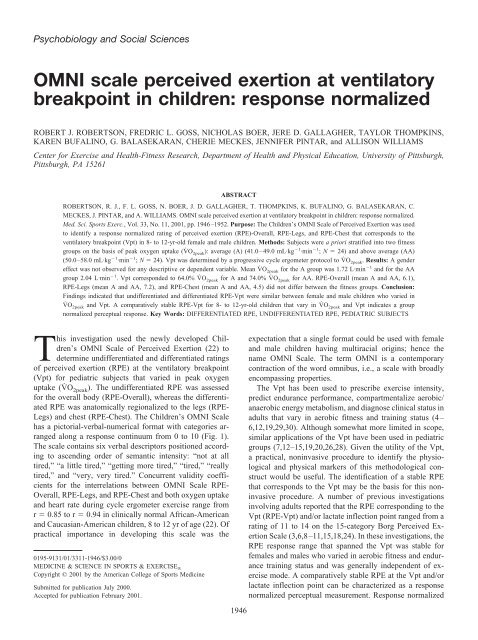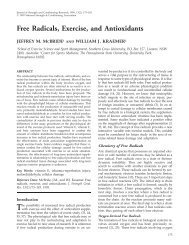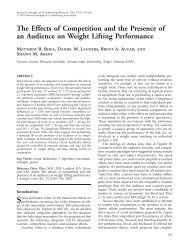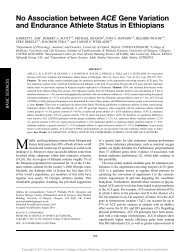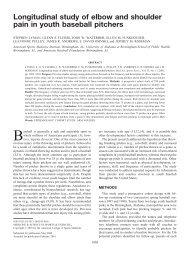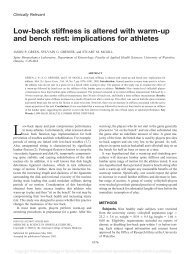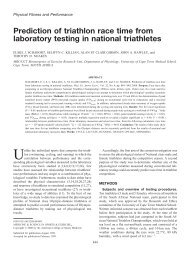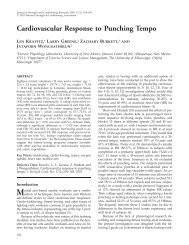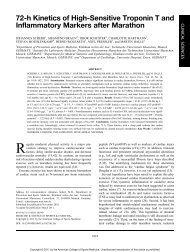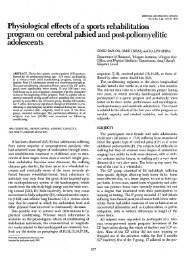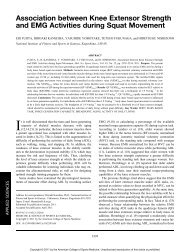OMNI scale perceived exertion at ventilatory breakpoint in children ...
OMNI scale perceived exertion at ventilatory breakpoint in children ...
OMNI scale perceived exertion at ventilatory breakpoint in children ...
You also want an ePaper? Increase the reach of your titles
YUMPU automatically turns print PDFs into web optimized ePapers that Google loves.
Psychobiology and Social Sciences<br />
<strong>OMNI</strong> <strong>scale</strong> <strong>perceived</strong> <strong>exertion</strong> <strong>at</strong> ventil<strong>at</strong>ory<br />
<strong>breakpo<strong>in</strong>t</strong> <strong>in</strong> <strong>children</strong>: response normalized<br />
ROBERT J. ROBERTSON, FREDRIC L. GOSS, NICHOLAS BOER, JERE D. GALLAGHER, TAYLOR THOMPKINS,<br />
KAREN BUFALINO, G. BALASEKARAN, CHERIE MECKES, JENNIFER PINTAR, and ALLISON WILLIAMS<br />
Center for Exercise and Health-Fitness Research, Department of Health and Physical Educ<strong>at</strong>ion, University of Pittsburgh,<br />
Pittsburgh, PA 15261<br />
ABSTRACT<br />
ROBERTSON, R. J., F. L. GOSS, N. BOER, J. D. GALLAGHER, T. THOMPKINS, K. BUFALINO, G. BALASEKARAN, C.<br />
MECKES, J. PINTAR, and A. WILLIAMS. <strong>OMNI</strong> <strong>scale</strong> <strong>perceived</strong> <strong>exertion</strong> <strong>at</strong> ventil<strong>at</strong>ory <strong>breakpo<strong>in</strong>t</strong> <strong>in</strong> <strong>children</strong>: response normalized.<br />
Med. Sci. Sports Exerc., Vol. 33, No. 11, 2001, pp. 1946–1952. Purpose: The Children’s <strong>OMNI</strong> Scale of Perceived Exertion was used<br />
to identify a response normalized r<strong>at</strong><strong>in</strong>g of <strong>perceived</strong> <strong>exertion</strong> (RPE)-Overall, RPE-Legs, and RPE-Chest th<strong>at</strong> corresponds to the<br />
ventil<strong>at</strong>ory <strong>breakpo<strong>in</strong>t</strong> (Vpt) <strong>in</strong> 8- to 12-yr-old female and male <strong>children</strong>. Methods: Subjects were a priori str<strong>at</strong>ified <strong>in</strong>to two fitness<br />
groups on the basis of peak oxygen uptake (V˙ O2peak): average (A) (41.0–49.0 mL·kg �1 ·m<strong>in</strong> �1 ; N � 24) and above average (AA)<br />
(50.0–58.0 mL·kg �1 ·m<strong>in</strong> �1 ; N � 24). Vpt was determ<strong>in</strong>ed by a progressive cycle ergometer protocol to V˙ O2peak. Results: A gender<br />
effect was not observed for any descriptive or dependent variable. Mean V˙ O2peak for the A group was 1.72 L·m<strong>in</strong> �1 and for the AA<br />
group 2.04 L·m<strong>in</strong> �1 . Vpt corresponded to 64.0% V˙ O2peak for A and 74.0% V˙ O2peak for AA. RPE-Overall (mean A and AA, 6.1),<br />
RPE-Legs (mean A and AA, 7.2), and RPE-Chest (mean A and AA, 4.5) did not differ between the fitness groups. Conclusion:<br />
F<strong>in</strong>d<strong>in</strong>gs <strong>in</strong>dic<strong>at</strong>ed th<strong>at</strong> undifferenti<strong>at</strong>ed and differenti<strong>at</strong>ed RPE-Vpt were similar between female and male <strong>children</strong> who varied <strong>in</strong><br />
V˙ O2peak and Vpt. A compar<strong>at</strong>ively stable RPE-Vpt for 8- to 12-yr-old <strong>children</strong> th<strong>at</strong> vary <strong>in</strong> V˙ O2peak and Vpt <strong>in</strong>dic<strong>at</strong>es a group<br />
normalized perceptual response. Key Words: DIFFERENTIATED RPE, UNDIFFERENTIATED RPE, PEDIATRIC SUBJECTS<br />
This <strong>in</strong>vestig<strong>at</strong>ion used the newly developed Children’s<br />
<strong>OMNI</strong> Scale of Perceived Exertion (22) to<br />
determ<strong>in</strong>e undifferenti<strong>at</strong>ed and differenti<strong>at</strong>ed r<strong>at</strong><strong>in</strong>gs<br />
of <strong>perceived</strong> <strong>exertion</strong> (RPE) <strong>at</strong> the ventil<strong>at</strong>ory <strong>breakpo<strong>in</strong>t</strong><br />
(Vpt) for pedi<strong>at</strong>ric subjects th<strong>at</strong> varied <strong>in</strong> peak oxygen<br />
uptake (V˙ O 2peak). The undifferenti<strong>at</strong>ed RPE was assessed<br />
for the overall body (RPE-Overall), whereas the differenti<strong>at</strong>ed<br />
RPE was an<strong>at</strong>omically regionalized to the legs (RPE-<br />
Legs) and chest (RPE-Chest). The Children’s <strong>OMNI</strong> Scale<br />
has a pictorial-verbal-numerical form<strong>at</strong> with c<strong>at</strong>egories arranged<br />
along a response cont<strong>in</strong>uum from 0 to 10 (Fig. 1).<br />
The <strong>scale</strong> conta<strong>in</strong>s six verbal descriptors positioned accord<strong>in</strong>g<br />
to ascend<strong>in</strong>g order of semantic <strong>in</strong>tensity: “not <strong>at</strong> all<br />
tired,” “a little tired,” “gett<strong>in</strong>g more tired,” “tired,” “really<br />
tired,” and “very, very tired.” Concurrent validity coefficients<br />
for the <strong>in</strong>terrel<strong>at</strong>ions between <strong>OMNI</strong> Scale RPE-<br />
Overall, RPE-Legs, and RPE-Chest and both oxygen uptake<br />
and heart r<strong>at</strong>e dur<strong>in</strong>g cycle ergometer exercise range from<br />
r � 0.85 to r � 0.94 <strong>in</strong> cl<strong>in</strong>ically normal African-American<br />
and Caucasian-American <strong>children</strong>, 8 to 12 yr of age (22). Of<br />
practical importance <strong>in</strong> develop<strong>in</strong>g this <strong>scale</strong> was the<br />
0195-9131/01/3311-1946/$3.00/0<br />
MEDICINE & SCIENCE IN SPORTS & EXERCISE ®<br />
Copyright © 2001 by the American College of Sports Medic<strong>in</strong>e<br />
Submitted for public<strong>at</strong>ion July 2000.<br />
Accepted for public<strong>at</strong>ion February 2001.<br />
1946<br />
expect<strong>at</strong>ion th<strong>at</strong> a s<strong>in</strong>gle form<strong>at</strong> could be used with female<br />
and male <strong>children</strong> hav<strong>in</strong>g multiracial orig<strong>in</strong>s; hence the<br />
name <strong>OMNI</strong> Scale. The term <strong>OMNI</strong> is a contemporary<br />
contraction of the word omnibus, i.e., a <strong>scale</strong> with broadly<br />
encompass<strong>in</strong>g properties.<br />
The Vpt has been used to prescribe exercise <strong>in</strong>tensity,<br />
predict endurance performance, compartmentalize aerobic/<br />
anaerobic energy metabolism, and diagnose cl<strong>in</strong>ical st<strong>at</strong>us <strong>in</strong><br />
adults th<strong>at</strong> vary <strong>in</strong> aerobic fitness and tra<strong>in</strong><strong>in</strong>g st<strong>at</strong>us (4–<br />
6,12,19,29,30). Although somewh<strong>at</strong> more limited <strong>in</strong> scope,<br />
similar applic<strong>at</strong>ions of the Vpt have been used <strong>in</strong> pedi<strong>at</strong>ric<br />
groups (7,12–15,19,20,26,28). Given the utility of the Vpt,<br />
a practical, non<strong>in</strong>vasive procedure to identify the physiological<br />
and physical markers of this methodological construct<br />
would be useful. The identific<strong>at</strong>ion of a stable RPE<br />
th<strong>at</strong> corresponds to the Vpt may be the basis for this non<strong>in</strong>vasive<br />
procedure. A number of previous <strong>in</strong>vestig<strong>at</strong>ions<br />
<strong>in</strong>volv<strong>in</strong>g adults reported th<strong>at</strong> the RPE correspond<strong>in</strong>g to the<br />
Vpt (RPE-Vpt) and/or lact<strong>at</strong>e <strong>in</strong>flection po<strong>in</strong>t ranged from a<br />
r<strong>at</strong><strong>in</strong>g of 11 to 14 on the 15-c<strong>at</strong>egory Borg Perceived Exertion<br />
Scale (3,6,8–11,15,18,24). In these <strong>in</strong>vestig<strong>at</strong>ions, the<br />
RPE response range th<strong>at</strong> spanned the Vpt was stable for<br />
females and males who varied <strong>in</strong> aerobic fitness and endurance<br />
tra<strong>in</strong><strong>in</strong>g st<strong>at</strong>us and was generally <strong>in</strong>dependent of exercise<br />
mode. A compar<strong>at</strong>ively stable RPE <strong>at</strong> the Vpt and/or<br />
lact<strong>at</strong>e <strong>in</strong>flection po<strong>in</strong>t can be characterized as a response<br />
normalized perceptual measurement. Response normalized
FIGURE 1—Children’s <strong>OMNI</strong> Scale of Perceived Exertion (22).<br />
model<strong>in</strong>g identifies either a stable RPE or RPE range th<strong>at</strong> (a)<br />
corresponds to an exercise <strong>in</strong>tensity th<strong>at</strong> produces a prescribed<br />
physiological and/or psychological outcome and (b)<br />
is common to a specified and def<strong>in</strong>ed <strong>in</strong>dividual and/or<br />
group (23).<br />
A compar<strong>at</strong>ively stable RPE-Vpt has been observed for<br />
selected pedi<strong>at</strong>ric subsets where assessments were made<br />
with the Borg 15-c<strong>at</strong>egory <strong>scale</strong> (7,14,15). The stability of<br />
this perceptual response may be practical when identify<strong>in</strong>g<br />
the Vpt <strong>in</strong> young <strong>children</strong> where the respir<strong>at</strong>ory-metabolic<br />
measurement procedures typically used <strong>in</strong> the assessment<br />
can be problem<strong>at</strong>ic. In previous <strong>in</strong>vestig<strong>at</strong>ions <strong>in</strong>volv<strong>in</strong>g<br />
pedi<strong>at</strong>ric samples, the RPE-Overall correspond<strong>in</strong>g to the<br />
Vpt ranged from 11 to 14 <strong>in</strong> female and male <strong>children</strong> 8 to<br />
12 yr of age. Determ<strong>in</strong><strong>at</strong>ion of a differenti<strong>at</strong>ed RPE (i.e.,<br />
Legs and Chest) th<strong>at</strong> is consonant with the Vpt <strong>in</strong> <strong>children</strong><br />
has been undertaken <strong>in</strong> only one previous <strong>in</strong>vestig<strong>at</strong>ion.<br />
Mahon et al. (15) reported th<strong>at</strong> RPE-Legs and RPE-Chest <strong>at</strong><br />
the Vpt dur<strong>in</strong>g cycle ergometer exercise were 14.1 and 12.6,<br />
respectively, <strong>in</strong> <strong>children</strong> hav<strong>in</strong>g a mean age of 10.9 yr.<br />
The present experiment used the Children’s <strong>OMNI</strong> Scale<br />
of Perceived Exertion to identify a response normalized<br />
RPE-Overall, RPE-Legs, and RPE-Chest th<strong>at</strong> corresponds<br />
to the Vpt <strong>in</strong> 8- to 12-yr-old female and male <strong>children</strong><br />
hav<strong>in</strong>g a V˙ O 2peak rang<strong>in</strong>g from 41.0 to 58.0 mL·kg �1 ·m<strong>in</strong> �1<br />
and a Vpt rang<strong>in</strong>g from 64.0 to 74.0% V˙ O 2peak. A substantial<br />
number of <strong>in</strong>vestig<strong>at</strong>ions us<strong>in</strong>g adult samples have demonstr<strong>at</strong>ed<br />
th<strong>at</strong> the RPE correspond<strong>in</strong>g to either the Vpt or<br />
lact<strong>at</strong>e <strong>in</strong>flection po<strong>in</strong>t was not affected by gender, tra<strong>in</strong><strong>in</strong>g<br />
st<strong>at</strong>us, exercise modality, or tra<strong>in</strong><strong>in</strong>g specificity<br />
(3,6,9,11,18,24). The experimental paradigms used <strong>in</strong> these<br />
<strong>in</strong>vestig<strong>at</strong>ions postul<strong>at</strong>ed th<strong>at</strong> the metabolic and/or physical<br />
<strong>in</strong>tensities equivalent to either the Vpt or lact<strong>at</strong>e <strong>in</strong>flection<br />
po<strong>in</strong>t would vary with a given <strong>in</strong>dependent variable (i.e.,<br />
aerobic fitness, tra<strong>in</strong><strong>in</strong>g st<strong>at</strong>us, and exercise modality),<br />
whereas the RPE range correspond<strong>in</strong>g to the <strong>breakpo<strong>in</strong>t</strong><br />
would be <strong>in</strong>variant. A conceptually similar paradigm was<br />
used presently where the RPE-Vpt was compared between<br />
groups of <strong>children</strong> th<strong>at</strong> had been a priori str<strong>at</strong>ified by a<br />
s<strong>in</strong>gle <strong>in</strong>dependent variable, i.e., V˙ O 2peak. The paradigm<br />
assumed th<strong>at</strong> the Vpt varied directly with V˙ O 2peak, i.e., Vpt<br />
would occur <strong>at</strong> a higher V˙ O 2 <strong>in</strong> the group hav<strong>in</strong>g the<br />
compar<strong>at</strong>ively higher than lower V˙ O 2peak (13,19,30). However,<br />
it was expected th<strong>at</strong> the RPE-Vpt determ<strong>in</strong>ed by the<br />
<strong>OMNI</strong> Scale would not differ between groups of female and<br />
male <strong>children</strong> who varied <strong>in</strong> V˙ O 2peak and as such their Vpt.<br />
A compar<strong>at</strong>ively stable RPE-Vpt for 8- to 12-yr-old female<br />
and male <strong>children</strong> who vary <strong>in</strong> their V˙ O 2peak and Vpt would<br />
be <strong>in</strong>dic<strong>at</strong>ive of a normalized perceptual response.<br />
METHODS<br />
Subjects. Forty-eight cl<strong>in</strong>ically normal, nonobese African-American<br />
and Caucasian-American female and male<br />
<strong>children</strong> rang<strong>in</strong>g <strong>in</strong> age from 8 to 12 yr particip<strong>at</strong>ed as<br />
subjects. Their descriptive characteristics are presented <strong>in</strong><br />
Table 1. Sample size was determ<strong>in</strong>ed for the st<strong>at</strong>istical<br />
power required to demonstr<strong>at</strong>e an <strong>in</strong>teraction effect with<strong>in</strong><br />
the repe<strong>at</strong>ed measures comparisons of RPE-Vpt (25). This<br />
power requirement was the most str<strong>in</strong>gent among any of the<br />
st<strong>at</strong>istical models used and as such required the gre<strong>at</strong>est<br />
number of subjects for each contrast cell. Us<strong>in</strong>g a power of<br />
0.80, an � level of 0.05, and an effect size of � 1.1, it was<br />
determ<strong>in</strong>ed th<strong>at</strong> n<strong>in</strong>e <strong>children</strong> were required <strong>in</strong> each of the<br />
four gender � fitness groups <strong>in</strong> order to test both the ma<strong>in</strong><br />
and <strong>in</strong>teraction effects. The with<strong>in</strong>-subject factor <strong>in</strong> the<br />
power calcul<strong>at</strong>ion assumed an <strong>in</strong>traclass correl<strong>at</strong>ion of r �<br />
0. 80 over the repe<strong>at</strong>ed measures. The power calcul<strong>at</strong>ion was<br />
derived from a previous report by Robertson et al. (22)<br />
where RPE was derived us<strong>in</strong>g the Children’s <strong>OMNI</strong> Scale.<br />
The total sample was divided <strong>in</strong>to two fitness groups, each<br />
hav<strong>in</strong>g 12 female African-American, 12 female Caucasian-<br />
American, 12 male African-American, and 12 male Caucasian-American<br />
<strong>children</strong>. Group assignment was determ<strong>in</strong>ed<br />
on the basis of measured cycle ergometer peak oxygen<br />
uptake <strong>in</strong>dexed to total body weight (V˙ O 2peak)<br />
(mL·kg �1 ·m<strong>in</strong> �1 ). Subjects who had a V˙ O 2peak between<br />
41.0 and 49.0 mL·kg �1 ·m<strong>in</strong> �1 were assigned to the “average”<br />
(A) aerobic fitness group and those who had a V˙ O 2peak<br />
between 50.0 and 58.0 mL·kg �1 ·m<strong>in</strong> �1 were assigned to the<br />
“above average” (AA) aerobic fitness group.<br />
Subjects were volunteers who demonstr<strong>at</strong>ed sufficient<br />
cognitive ability to read out loud each verbal descriptor on<br />
the Children’s <strong>OMNI</strong> Scale. Medical clearance to undertake<br />
exercise test<strong>in</strong>g was required before particip<strong>at</strong>ion. Risks and<br />
benefits were expla<strong>in</strong>ed and the subject and his/her parent/<br />
guardian gave their written consent to particip<strong>at</strong>e. Subjects<br />
did not have cardiovascular, neuromotor, or cognitive contra<strong>in</strong>dic<strong>at</strong>ions<br />
to exercise test<strong>in</strong>g as determ<strong>in</strong>ed dur<strong>in</strong>g the<br />
preparticip<strong>at</strong>ion medical exam<strong>in</strong><strong>at</strong>ion. The experimental<br />
protocol to use <strong>children</strong> as research subjects was approved<br />
by the University of Pittsburgh Institutional Review Board.<br />
Experimental design and test sessions. The <strong>in</strong>vestig<strong>at</strong>ion<br />
used a cross-sectional experimental design consist<strong>in</strong>g<br />
of two labor<strong>at</strong>ory test<strong>in</strong>g sessions separ<strong>at</strong>ed by a m<strong>in</strong>imum<br />
of 48 h and maximum of 72 h. Dur<strong>in</strong>g the first session,<br />
subjects were familiarized with cycle ergometer exercise<br />
test<strong>in</strong>g and use of the Children’s <strong>OMNI</strong> Scale of Perceived<br />
Exertion. The cycle familiariz<strong>at</strong>ion procedures consisted of<br />
three 3-m<strong>in</strong> power output stages (25, 50, and 75 W) presented<br />
cont<strong>in</strong>uously <strong>in</strong> ascend<strong>in</strong>g order of <strong>in</strong>tensity. Particular<br />
<strong>at</strong>tention was directed to proper pedal<strong>in</strong>g cadence. A<br />
respir<strong>at</strong>ory valve/mouthpiece and heart r<strong>at</strong>e monitor were<br />
RPE AT VENTILATORY BREAKPOINT Medic<strong>in</strong>e & Science <strong>in</strong> Sports & Exercise � 1947
TABLE 1. Descriptive characteristics of 8- to 12-yr-old female and male subjects.<br />
V˙O 2peak<br />
Age (yr) Ht (cm) Wt (kg)<br />
(mL�kg<br />
Fitness<br />
–1�m<strong>in</strong> –1 )<br />
M � SD M � SD M � SD M � SD<br />
A-Female 10.0 � 1.3 143.3 � 7.5 38.0 � 2.3 44.6 � 3.0<br />
A-Male 9.8 � 1.6 142.6 � 7.6 38.0 � 2.1 45.0 � 2.6<br />
AA-Female 10.3 � 1.4 144.0 � 9.6 37.4 � 2.0 54.4 � 2.2<br />
AA-Male 10.0 � 1.7 143.3 � 9.9 37.3 � 1.7 54.5 � 2.3<br />
Source<br />
F<br />
positioned on the subject dur<strong>in</strong>g the orient<strong>at</strong>ion session.<br />
Subjects were <strong>in</strong>structed regard<strong>in</strong>g the use of the Children’s<br />
<strong>OMNI</strong> Scale before the cycle orient<strong>at</strong>ion and practiced<br />
r<strong>at</strong><strong>in</strong>g their RPE-Overall, RPE-Legs, and RPE-Chest dur<strong>in</strong>g<br />
each exercise stage. At the beg<strong>in</strong>n<strong>in</strong>g of the orient<strong>at</strong>ion<br />
session, body weight (kg) and height (cm) were determ<strong>in</strong>ed<br />
with a Detect-Medic Scale and <strong>at</strong>tached stadiometer (Detecto<br />
Scales, Inc., Brooklyn, NY).<br />
The second session consisted of a perceptual estim<strong>at</strong>ion<br />
exercise test adm<strong>in</strong>istered on a Monark (Model 864, Sweden)<br />
cycle ergometer equipped with a pl<strong>at</strong>e-load<strong>in</strong>g system<br />
to apply brake force. A progressive multistage test protocol<br />
was used. The <strong>in</strong>itial brake resistance was 25 W and was<br />
<strong>in</strong>cremented by 10 W <strong>at</strong> the beg<strong>in</strong>n<strong>in</strong>g of each 3-m<strong>in</strong> test<br />
stage. Test term<strong>in</strong><strong>at</strong>ion was def<strong>in</strong>ed as the <strong>in</strong>ability to ma<strong>in</strong>ta<strong>in</strong><br />
the design<strong>at</strong>ed pedal r<strong>at</strong>e for 15 consecutive seconds<br />
ow<strong>in</strong>g to exhaustion. A pedal r<strong>at</strong>e of 50 rpm signaled by an<br />
electronic metronome was used for the entire test protocol.<br />
Ventil<strong>at</strong>ory <strong>breakpo<strong>in</strong>t</strong>. The Vpt was identified us<strong>in</strong>g<br />
respir<strong>at</strong>ory-gas exchange measurements obta<strong>in</strong>ed every 15 s<br />
dur<strong>in</strong>g the multistage cycle exercise test. The ventil<strong>at</strong>ory<br />
equivalents for oxygen (V˙ E:V˙ O 2) and carbon dioxide (V˙ E:<br />
V˙ CO 2) were plotted as a function of V˙ O 2. The measurement<br />
criterion for the Vpt was taken as the V˙ O 2 <strong>at</strong> which V˙ E:V˙ O 2<br />
<strong>in</strong>creased without a concomitant <strong>in</strong>crease <strong>in</strong> V˙ E:V˙ CO 2<br />
(4,15,28). The Vpt was detectable from <strong>in</strong>dividual plots for<br />
each subject and was expressed <strong>in</strong> both absolute (L·m<strong>in</strong> �1 )<br />
and rel<strong>at</strong>ive (%V˙ O 2peak) units.<br />
Cardiorespir<strong>at</strong>ory and Aerobic Metabolic<br />
Measures<br />
Heart r<strong>at</strong>e (HR) (be<strong>at</strong>s·m<strong>in</strong> �1 ) was measured from 45 to<br />
60 s dur<strong>in</strong>g each m<strong>in</strong>ute of exercise us<strong>in</strong>g a Polar monitor<strong>in</strong>g<br />
system (Polar Electro, F<strong>in</strong>land). Respir<strong>at</strong>ory-metabolic and<br />
gas exchange variables were measured with an autom<strong>at</strong>ed<br />
open circuit <strong>in</strong>direct calorimetric system (MedGraphics,<br />
Inc., St. Paul, MN). Oxygen uptake (V˙ O2)(L·m<strong>in</strong> �1 ), carbon<br />
dioxide production (V˙ CO2)(L·m<strong>in</strong> �1 ), and respir<strong>at</strong>ory<br />
flow (V˙ E) (L·m<strong>in</strong> �1 ) were determ<strong>in</strong>ed every 15 s and expressed<br />
as STPD. A standard respir<strong>at</strong>ory valve (Model<br />
2700; Hans Rudolph, Kansas City, MO) with a child-size<br />
Age Ht Wt V˙O 2peak<br />
P<br />
Value F<br />
P<br />
Value F<br />
P<br />
Value F<br />
Gender 0.45 0.50 0.08 0.78 0.01 0.94 0.08 0.78<br />
Fitness 0.45 0.50 0.08 0.78 1.10 0.29 174.20 0.01*<br />
Gender � fitness 0.01 0.92 0.01 0.99 0.01 0.94 0.08 0.78<br />
Ht, height; Wt, weight; V˙ O2peak, peak oxygen uptake; A, average fitness; AA, above average fitness.<br />
D<strong>at</strong>a are means (M) � standard devi<strong>at</strong>ion (SD); df: gender � 1, fitness � 1, gender � fitness � 1, error � 44.<br />
* Significant.<br />
P<br />
Value<br />
mouthpiece was used for all respir<strong>at</strong>ory-metabolic measurements.<br />
V˙ O 2peak was taken as the highest 60-s value recorded<br />
dur<strong>in</strong>g the f<strong>in</strong>al stage of the cycle exercise protocol. Confirm<strong>in</strong>g<br />
criteria <strong>in</strong>cluded <strong>at</strong>ta<strong>in</strong>ment of � 5 be<strong>at</strong>s·m<strong>in</strong> �1 of<br />
the age-predicted peak value for the subjects studied (i.e.,<br />
195 be<strong>at</strong>s·m<strong>in</strong> �1 ) and a respir<strong>at</strong>ory exchange r<strong>at</strong>io (RER) �<br />
1.1.<br />
R<strong>at</strong><strong>in</strong>gs of Perceived Exertion<br />
The Children’s <strong>OMNI</strong> Sale was used to estim<strong>at</strong>e three<br />
separ<strong>at</strong>e RPE between 30 and 60 s of each m<strong>in</strong>ute of<br />
exercise. An undifferenti<strong>at</strong>ed r<strong>at</strong><strong>in</strong>g was estim<strong>at</strong>ed for the<br />
overall body (RPE-Overall) and a differenti<strong>at</strong>ed r<strong>at</strong><strong>in</strong>g was<br />
estim<strong>at</strong>ed for peripheral perceptions of <strong>exertion</strong> <strong>in</strong> the legs<br />
(RPE-Legs) and respir<strong>at</strong>ory-metabolic perceptions <strong>in</strong> the<br />
chest (RPE-Chest). A def<strong>in</strong>ition of <strong>perceived</strong> <strong>exertion</strong> specifically<br />
developed for <strong>children</strong> and a standard set of <strong>in</strong>structions<br />
regard<strong>in</strong>g use of the <strong>OMNI</strong> Scale to r<strong>at</strong>e perceptions<br />
of <strong>exertion</strong> were read to the subject immedi<strong>at</strong>ely before<br />
the exercise test (22), as follows:<br />
Def<strong>in</strong>ition: How “tired” does your body feel dur<strong>in</strong>g<br />
exercise?<br />
Instructions: We would like you to ride on the bicycle for a<br />
little while. Every few m<strong>in</strong>utes it will get harder to pedal<br />
the bicycle. Please use the numbers on this picture to tell<br />
us how your body feels when bicycl<strong>in</strong>g. Please look <strong>at</strong> the<br />
person <strong>at</strong> the bottom of the hill who is just start<strong>in</strong>g to ride<br />
a bicycle (po<strong>in</strong>t to left pictorial). If you feel like this<br />
person when you are rid<strong>in</strong>g you will be “not tired <strong>at</strong> all.”<br />
You should po<strong>in</strong>t to a 0. Now look <strong>at</strong> the person who is<br />
barely able to ride a bicycle to the top of the hill (po<strong>in</strong>t to<br />
the right pictorial). If you feel like this person when rid<strong>in</strong>g<br />
you will be “very, very tired.” You should po<strong>in</strong>t to a<br />
number 10. If you feel somewhere <strong>in</strong> between “not tired<br />
<strong>at</strong> all” (0) and “very, very tired” (10), then po<strong>in</strong>t to a<br />
number between 0 and 10.<br />
We will ask you to po<strong>in</strong>t to a number th<strong>at</strong> tells how your<br />
whole body feels, then a number th<strong>at</strong> tells how your legs<br />
feel, and then a number th<strong>at</strong> tells how your bre<strong>at</strong>h<strong>in</strong>g<br />
feels. Remember, there are no right or wrong numbers.<br />
1948 Official Journal of the American College of Sports Medic<strong>in</strong>e http://www.acsm-msse.org
Use both the pictures and words to help select the numbers.<br />
Use any of the numbers to tell how you feel when<br />
rid<strong>in</strong>g the bicycle.<br />
The low and high perceptual anchors for the <strong>OMNI</strong> Scale<br />
were established us<strong>in</strong>g the procedure reported previously by<br />
Robertson et al. (22). This procedure requires the subject to<br />
cognitively establish a <strong>perceived</strong> <strong>in</strong>tensity of <strong>exertion</strong> th<strong>at</strong> is<br />
consonant with th<strong>at</strong> depicted visually by the cyclist <strong>at</strong> the<br />
bottom (i.e., low anchor, r<strong>at</strong><strong>in</strong>g 0) and top (i.e., high anchor,<br />
r<strong>at</strong><strong>in</strong>g 10) of the hill as presented <strong>in</strong> the <strong>OMNI</strong> Scale<br />
illustr<strong>at</strong>ions. Subjects were <strong>in</strong>structed to r<strong>at</strong>e us<strong>in</strong>g whole<br />
numbers only. The r<strong>at</strong><strong>in</strong>g was repe<strong>at</strong>ed to the subject to<br />
confirm its accuracy. The <strong>OMNI</strong> Scale was <strong>in</strong> full view of<br />
the subject <strong>at</strong> all times dur<strong>in</strong>g test<strong>in</strong>g. As a respir<strong>at</strong>ory valve<br />
prohibited a verbal r<strong>at</strong><strong>in</strong>g response, subjects po<strong>in</strong>ted to their<br />
RPE on the <strong>OMNI</strong> Scale.<br />
D<strong>at</strong>a analysis. Age, height, and weight were calcul<strong>at</strong>ed<br />
as means � standard devi<strong>at</strong>ions (SD) and reported separ<strong>at</strong>ely<br />
for female and male <strong>children</strong> with<strong>in</strong> the two fitness<br />
groups. Descriptive d<strong>at</strong>a were compared us<strong>in</strong>g a two-factor<br />
(gender � fitness) analysis of variance (ANOVA). The<br />
physiological responses <strong>at</strong> peak exercise (i.e., V˙ O 2, HR, and<br />
RER) and <strong>at</strong> the Vpt (i.e., %V˙ O 2peak, V˙ O 2, and HR) dur<strong>in</strong>g<br />
the cycle ergometer test were also compared us<strong>in</strong>g a gender<br />
� fitness ANOVA. RPE-Overall, RPE-Legs, and RPE-<br />
Chest determ<strong>in</strong>ed <strong>at</strong> peak exercise and <strong>at</strong> the Vpt dur<strong>in</strong>g the<br />
cycle ergometer test were exam<strong>in</strong>ed by a three-factor (RPE<br />
� gender � fitness) ANOVA with repe<strong>at</strong>ed measures on the<br />
first factor. Significant ma<strong>in</strong> and <strong>in</strong>teraction effects were<br />
analyzed with a simple effects post hoc procedure. All<br />
analyses were performed us<strong>in</strong>g an SPSS for W<strong>in</strong>dows 8.0<br />
(1997) st<strong>at</strong>istical package (SPSS, Inc., Chicago, IL).<br />
RESULTS<br />
Descriptive characteristics. The descriptive characteristics<br />
of the female and male subjects <strong>in</strong> the two fitness<br />
groups are presented <strong>in</strong> Table 1. Neither the gender and<br />
fitness ma<strong>in</strong> effects nor the gender � fitness <strong>in</strong>teraction<br />
effect were significant for age, height, and weight, <strong>in</strong>dic<strong>at</strong><strong>in</strong>g<br />
th<strong>at</strong> these descriptive variables did not differ between<br />
the four experimental group<strong>in</strong>gs. The fitness ma<strong>in</strong> effect for<br />
V˙ O 2peak (mL·kg �1 ·m<strong>in</strong> �1 ) was significant (P � 0.01),<br />
whereas the gender ma<strong>in</strong> effect and gender � fitness <strong>in</strong>teraction<br />
effect were not significant. As such, V˙ O 2peak<br />
(mL·kg �1 ·m<strong>in</strong> �1 ) was higher (P � 0.01) for the AA than A<br />
group irrespective of gender.<br />
The mean � SD physiological responses <strong>at</strong> peak cycle<br />
ergometer exercise are listed <strong>in</strong> Table 2. A summary of the<br />
ANOVA for these d<strong>at</strong>a is also listed <strong>in</strong> this table. A significant<br />
(P � 0.01) fitness ma<strong>in</strong> effect was found for V˙ O 2peak,<br />
whereas the gender ma<strong>in</strong> effect and the gender � fitness<br />
<strong>in</strong>teraction effect were not significant. The gender and fitness<br />
ma<strong>in</strong> effects and the gender � fitness <strong>in</strong>teraction effect<br />
were not significant for HR and RER <strong>at</strong> peak <strong>in</strong>tensities.<br />
These analyses <strong>in</strong>dic<strong>at</strong>ed th<strong>at</strong> V˙ O 2peak (L·m<strong>in</strong> �1 ) was higher<br />
for the AA than A group <strong>in</strong>dependent of gender. Peak values<br />
TABLE 2. Peak physiological responses dur<strong>in</strong>g graded cycle ergometer exercise <strong>in</strong><br />
8- to 12-yr-old female and male subjects.<br />
Fitness M � SD M � SD M � SD<br />
A-Female 1.72 � 0.20 194.0 � 4.9 1.09 � 0.04<br />
A-Male 1.79 � 0.21 194.7 � 4.3 1.10 � 0.03<br />
AA-Female 2.04 � 0.24 196.0 � 6.1 1.10 � 0.04<br />
AA-Male 2.10 � 0.17 196.4 � 6.1 1.10 � 0.04<br />
Source<br />
for HR and RER did not differ between the four gender �<br />
fitness groups.<br />
Figure 2A presents the mean � SD RPE responses <strong>at</strong><br />
peak exercise. The ANOVA for these d<strong>at</strong>a are summarized<br />
<strong>in</strong> Table 3. St<strong>at</strong>istical significance was not found for either<br />
the RPE, gender, and fitness ma<strong>in</strong> effects or any of the<br />
<strong>in</strong>teraction effects. The Mauchly W (0.95) test of sphericity<br />
was not significant (P � 0.35). These analyses <strong>in</strong>dic<strong>at</strong>ed th<strong>at</strong><br />
the undifferenti<strong>at</strong>ed and differenti<strong>at</strong>ed RPE <strong>at</strong> peak exercise<br />
<strong>in</strong>tensity did not differ between the four gender � fitness<br />
experimental group<strong>in</strong>gs.<br />
The physiological responses <strong>at</strong> the Vpt are listed <strong>in</strong> Table<br />
4. St<strong>at</strong>istical analysis <strong>in</strong>dic<strong>at</strong>ed th<strong>at</strong> the fitness ma<strong>in</strong> effect<br />
was significant (P � 0.01), whereas the gender ma<strong>in</strong> effect<br />
and the gender � fitness <strong>in</strong>teraction effect were not significant<br />
for %V˙ O 2peak, V˙ O 2, and HR <strong>at</strong> the Vpt. The analyses<br />
<strong>in</strong>dic<strong>at</strong>ed th<strong>at</strong> each of the physiological responses <strong>at</strong> Vpt was<br />
significantly higher for the AA than A group <strong>in</strong>dependent of<br />
gender. Figure 2B presents the undifferenti<strong>at</strong>ed and differenti<strong>at</strong>ed<br />
<strong>perceived</strong> <strong>exertion</strong> responses <strong>at</strong> the Vpt. The<br />
ANOVA for these d<strong>at</strong>a are summarized <strong>in</strong> Table 5. The<br />
ma<strong>in</strong> effect for RPE was significant (P � 0.01), whereas the<br />
ma<strong>in</strong> effects for fitness and gender were not significant.<br />
Significant <strong>in</strong>teraction effects were not found. The Mauchly<br />
W (0.99) test of sphericity was not significant (P � 0.86).<br />
These analyses <strong>in</strong>dic<strong>at</strong>ed th<strong>at</strong> when measured <strong>at</strong> the Vpt,<br />
RPE-Overall, RPE-Legs, and RPE-Chest did not differ between<br />
any of the four gender � fitness groups. Post hoc<br />
analysis of the RPE ma<strong>in</strong> effect <strong>in</strong>dic<strong>at</strong>ed th<strong>at</strong> with<strong>in</strong> all four<br />
gender � fitness groups, RPE-Legs was gre<strong>at</strong>er than<br />
RPE-Chest.<br />
DISCUSSION<br />
V˙O 2<br />
(L�m<strong>in</strong> –1 )<br />
F<br />
HR<br />
(be<strong>at</strong>s�m<strong>in</strong> –1 ) RER<br />
V˙O 2 HR RER<br />
P<br />
Value F<br />
P<br />
Value F<br />
P<br />
Value<br />
Gender 0.04 0.84 0.12 0.73 0.35 0.56<br />
Fitness 36.20 0.01* 1.40 0.24 1.02 0.32<br />
Gender � fitness 0.00 0.99 0.01 0.94 0.03 0.86<br />
V˙ O2, oxygen uptake; HR, heart r<strong>at</strong>e; RER, respir<strong>at</strong>ory exchange r<strong>at</strong>io; A, average fitness;<br />
AA, above average fitness.<br />
D<strong>at</strong>a are means (M) � standard devi<strong>at</strong>ion (SD); df: gender � 1, fitness � 1,<br />
gender � fitness � 1, error � 44.<br />
* Significant.<br />
Descriptive d<strong>at</strong>a. The mean � SD V˙ O 2peak for the four<br />
gender � fitness experimental groups fell with<strong>in</strong> the ranges<br />
reported previously for North American female and male<br />
<strong>children</strong> 8 to 12 yr of age (28). The mean Vpt was 64.0%<br />
V˙ O 2peak for the A cohort and 74.0% V˙ O 2peak for the AA<br />
cohort. These d<strong>at</strong>a are generally consistent with previous<br />
RPE AT VENTILATORY BREAKPOINT Medic<strong>in</strong>e & Science <strong>in</strong> Sports & Exercise � 1949
FIGURE 2—Mean � SD r<strong>at</strong><strong>in</strong>gs of <strong>perceived</strong> <strong>exertion</strong> (RPE: <strong>OMNI</strong><br />
Scale) <strong>at</strong> peak exercise (A) and ventil<strong>at</strong>ory <strong>breakpo<strong>in</strong>t</strong> (B) <strong>in</strong> female<br />
and male <strong>children</strong> (8–12 yr) with average (41.0–49.0 mL·kg �1 ·m<strong>in</strong> �1 )<br />
and above average (50.0–58.0 mL·kg �1 ·m<strong>in</strong> �1 ) peak oxygen uptake<br />
(V˙ O 2peak).<br />
experiments th<strong>at</strong> have determ<strong>in</strong>ed Vpt dur<strong>in</strong>g cycle ergometry<br />
us<strong>in</strong>g cl<strong>in</strong>ically normal <strong>children</strong> who varied <strong>in</strong> peak<br />
aerobic power (7,15,27,28).<br />
Of importance from a perceptual scal<strong>in</strong>g perspective are<br />
the RPE responses obta<strong>in</strong>ed <strong>at</strong> peak cycle exercise <strong>in</strong>tensity<br />
<strong>in</strong> the four gender � fitness groups. The upper term<strong>in</strong>al RPE<br />
derived from the <strong>OMNI</strong> Scale was very close to 10 for both<br />
the undifferenti<strong>at</strong>ed and differenti<strong>at</strong>ed responses when exam<strong>in</strong>ed<br />
across <strong>in</strong>dividual subjects. When us<strong>in</strong>g c<strong>at</strong>egory<br />
r<strong>at</strong><strong>in</strong>g <strong>scale</strong>s to estim<strong>at</strong>e <strong>exertion</strong>al perceptions, it is important<br />
th<strong>at</strong> the upper term<strong>in</strong>al c<strong>at</strong>egory (i.e., 10, <strong>OMNI</strong> Scale)<br />
on the perceptual response range generally corresponds to<br />
<strong>at</strong>ta<strong>in</strong>ment of peak <strong>in</strong>tensity on the exercise stimulus range.<br />
Such correspondence is consonant with the basic tenants of<br />
Borg’s Range Model (16,p.60) and is methodologically requisite<br />
to <strong>in</strong>ter<strong>in</strong>dividual comparisons of c<strong>at</strong>egory r<strong>at</strong><strong>in</strong>g <strong>scale</strong><br />
responses. The Range Model predicts th<strong>at</strong> the highest term<strong>in</strong>al<br />
response c<strong>at</strong>egory should be similar between undifferenti<strong>at</strong>ed<br />
and differenti<strong>at</strong>ed perceptual signals <strong>at</strong> peak exercise<br />
<strong>in</strong>tensity when signal-specific anchor<strong>in</strong>g procedures<br />
are used. The perceptual responses <strong>at</strong> peak cycle ergometer<br />
exercise obta<strong>in</strong>ed presently provide evidence th<strong>at</strong> the pic-<br />
torially <strong>in</strong>terfaced cognitive <strong>scale</strong> anchor<strong>in</strong>g procedures (22)<br />
used <strong>in</strong> conjunction with the Children’s <strong>OMNI</strong> Scale were<br />
understood and appropri<strong>at</strong>ely applied by the subjects.<br />
RPE-Overall <strong>at</strong> Vpt. In the present <strong>in</strong>vestig<strong>at</strong>ion, it was<br />
hypothesized th<strong>at</strong> the RPE-Overall correspond<strong>in</strong>g to the Vpt<br />
dur<strong>in</strong>g cycle ergometry would be similar between pedi<strong>at</strong>ric<br />
groups th<strong>at</strong> differed <strong>in</strong> both their peak aerobic power (i.e.,<br />
“average” vs “above average”) and <strong>in</strong> the %V˙ O 2peak th<strong>at</strong><br />
was equivalent to their <strong>in</strong>dividually determ<strong>in</strong>ed Vpt. The<br />
f<strong>in</strong>d<strong>in</strong>gs supported this experimental hypothesis. The RPE-<br />
Overall-Vpt was � 6 for both the A and AA groups. This<br />
numerical c<strong>at</strong>egory corresponds to the verbal descriptor<br />
“tired” on the <strong>OMNI</strong> Scale. The f<strong>in</strong>d<strong>in</strong>g is <strong>in</strong>dic<strong>at</strong>ive of a<br />
response normalized RPE-Overall-Vpt (<strong>OMNI</strong> Scale) for 8to<br />
12-yr-old female and male <strong>children</strong> hav<strong>in</strong>g a V˙ O 2peak<br />
between 41 and 58 mL·kg �1 ·m<strong>in</strong> �1 .<br />
The variability <strong>in</strong> RPE-Overall-Vpt derived from the<br />
<strong>OMNI</strong> Scale was compar<strong>at</strong>ively small as evidenced by an<br />
SD of � 0.62 for the low and � 0.66 for the high cohort.<br />
Individual RPE-Overall-Vpt ranged from 5 to 7 with<strong>in</strong> both<br />
fitness groups. The <strong>OMNI</strong> Scale conta<strong>in</strong>s developmentally<br />
and cognitively discrete measurement properties specific to<br />
<strong>children</strong> 12 yr of age and younger (22). The compar<strong>at</strong>ively<br />
small variability <strong>in</strong> response normalized RPE-Overall-Vpt<br />
derived from the <strong>OMNI</strong> Scale <strong>in</strong> the present <strong>in</strong>vestig<strong>at</strong>ion<br />
reflects these measurement properties. A narrow perceptual<br />
response range correspond<strong>in</strong>g to a “target” physiological<br />
reference is necessary for various response normalized applic<strong>at</strong>ions<br />
of RPE <strong>in</strong>volv<strong>in</strong>g prescription and regul<strong>at</strong>ion of<br />
exercise <strong>in</strong>tensity.<br />
Differenti<strong>at</strong>ed RPE. R<strong>at</strong><strong>in</strong>gs of <strong>perceived</strong> <strong>exertion</strong> th<strong>at</strong><br />
are an<strong>at</strong>omically differenti<strong>at</strong>ed to specific body regions such<br />
as the legs and chest are often used, respectively, <strong>in</strong> limbspecific<br />
exercise prescriptions (1) and <strong>in</strong> cl<strong>in</strong>ical assessment<br />
of <strong>exertion</strong>al dyspnea (16,pp.245–247). Both of these procedures<br />
<strong>in</strong>volv<strong>in</strong>g differenti<strong>at</strong>ed RPE can be facilit<strong>at</strong>ed by<br />
response normalized perceptual model<strong>in</strong>g.<br />
It was hypothesized th<strong>at</strong> both the RPE-Legs-Vpt and<br />
RPE-Chest-Vpt dur<strong>in</strong>g cycle ergometry would be similar<br />
between pedi<strong>at</strong>ric groups differ<strong>in</strong>g <strong>in</strong> peak aerobic power.<br />
The f<strong>in</strong>d<strong>in</strong>gs were consistent with this experimental hypothesis.<br />
Both RPE-Legs and RPE-Chest exhibited stable responsiveness<br />
between the four gender � fitness groups<br />
when measured <strong>at</strong> the Vpt. The present responses provide<br />
evidence th<strong>at</strong> the <strong>OMNI</strong> Scale can be used to identify<br />
response normalized RPE-Vpt th<strong>at</strong> are an<strong>at</strong>omically differenti<strong>at</strong>ed<br />
to the legs and chest <strong>in</strong> 8- to 12-yr-old <strong>children</strong>.<br />
A differenti<strong>at</strong>ed <strong>exertion</strong>al r<strong>at</strong><strong>in</strong>g aris<strong>in</strong>g from the legs<br />
reflects peripheral perceptual signals, whereas a r<strong>at</strong><strong>in</strong>g differenti<strong>at</strong>ed<br />
to the chest reflects respir<strong>at</strong>ory-metabolic perceptual<br />
signals (16,pp.105–106). A number of previous experiments<br />
<strong>in</strong>volv<strong>in</strong>g adult (17,21) and pedi<strong>at</strong>ric (2,15)<br />
groups observed th<strong>at</strong> RPE-Legs was higher than RPE-Chest<br />
(2,17,21) when exam<strong>in</strong>ed over a compar<strong>at</strong>ively wide range<br />
of cycle ergometer exercise <strong>in</strong>tensities. Although it was not<br />
possible to ascerta<strong>in</strong> st<strong>at</strong>istical significance, Mahon et al.<br />
(15) us<strong>in</strong>g the Borg Scale reported th<strong>at</strong> RPE-Legs was<br />
gre<strong>at</strong>er than RPE-Chest <strong>in</strong> young <strong>children</strong> exercis<strong>in</strong>g <strong>at</strong> an<br />
1950 Official Journal of the American College of Sports Medic<strong>in</strong>e http://www.acsm-msse.org
TABLE 3. Summary of ANOVA for RPE <strong>at</strong> peak exercise <strong>in</strong>tensity and the ventil<strong>at</strong>ory <strong>breakpo<strong>in</strong>t</strong>.<br />
<strong>in</strong>tensity equivalent to the Vpt. Similarly, <strong>in</strong> the present<br />
<strong>in</strong>vestig<strong>at</strong>ion, RPE-Legs <strong>at</strong> the Vpt was found to be the<br />
dom<strong>in</strong>ant perceptual signal for the four gender � fitness<br />
groups th<strong>at</strong> were studied. These f<strong>in</strong>d<strong>in</strong>gs <strong>in</strong>dic<strong>at</strong>e th<strong>at</strong> the<br />
Children’s <strong>OMNI</strong> Scale is an effective psychometric tool to<br />
assess the compar<strong>at</strong>ive strength of differenti<strong>at</strong>ed perceptual<br />
signals <strong>at</strong> exercise <strong>in</strong>tensities equivalent to the Vpt dur<strong>in</strong>g<br />
cycle ergometry.<br />
Gender effect: RPE-Vpt. The undifferenti<strong>at</strong>ed and<br />
differenti<strong>at</strong>ed RPE-Vpt did not differ between females<br />
and males with<strong>in</strong> and between fitness group<strong>in</strong>gs. Previous<br />
<strong>in</strong>vestig<strong>at</strong>ions (19,20,28) report th<strong>at</strong> the Vpt is generally<br />
<strong>in</strong>dependent of gender <strong>in</strong> young <strong>children</strong> (i.e., �12 yr of<br />
age), provided th<strong>at</strong> V˙ O 2max/peak does not differ between<br />
gender group<strong>in</strong>gs. As such, it was expected th<strong>at</strong> the<br />
RPE-Vpt would not differ between female and male <strong>children</strong><br />
with<strong>in</strong> a given fitness group. The perceptual responses<br />
confirmed this hypothesis. The f<strong>in</strong>d<strong>in</strong>gs of a<br />
stable undifferenti<strong>at</strong>ed and differenti<strong>at</strong>ed RPE-Vpt determ<strong>in</strong>ed<br />
by the <strong>OMNI</strong> Scale applies to both female and<br />
male <strong>children</strong> (8–12 yr old) who are classified as average<br />
to above average <strong>in</strong> aerobic fitness.<br />
Response normalized RPE applic<strong>at</strong>ions. The identific<strong>at</strong>ion<br />
of a response normalized RPE correspond<strong>in</strong>g to<br />
the physiological and/or physical parameters th<strong>at</strong> def<strong>in</strong>e the<br />
TABLE 4. Physiological responses <strong>at</strong> the ventil<strong>at</strong>ory <strong>breakpo<strong>in</strong>t</strong> dur<strong>in</strong>g cycle<br />
ergometer exercise <strong>in</strong> 8- to 12-yr-old female and male subjects.<br />
%V˙O 2peak<br />
V˙O 2<br />
(L�m<strong>in</strong> –1 )<br />
HR<br />
(be<strong>at</strong>s�m<strong>in</strong> –1 )<br />
Fitness M � SD M � SD M � SD<br />
A-Female 64.0 � 3.3 1.10 � 0.18 148.8 � 5.5<br />
A-Male 63.5 � 3.1 1.20 � 0.18 149.3 � 5.5<br />
AA-Female 74.0 � 3.8 1.51 � 0.16 163.1 � 5.6<br />
AA-Male 73.5 � 3.7 1.50 � 0.17 165.1 � 5.8<br />
Source<br />
Source<br />
F<br />
%V˙O 2peak V˙O 2 HR<br />
P<br />
Value F<br />
df F<br />
P<br />
Value F<br />
P<br />
Value<br />
Gender 0.24 0.63 0.00 0.99 0.02 0.88<br />
Fitness 94.60 0.01* 69.30 0.01* 77.01 0.01*<br />
Gender � fitness 0.00 1.0 0.00 0.99 0.02 0.88<br />
%V˙ O2peak, percent of peak oxygen uptake; V˙ O2, oxygen uptake; HR, heart r<strong>at</strong>e; A,<br />
average fitness; AA, above average fitness.<br />
D<strong>at</strong>a are means (M) � standard devi<strong>at</strong>ion (SD); df: gender � 1, fitness � 1,<br />
gender � fitness � 1, error � 44.<br />
* Significant.<br />
Peak Exercise Ventil<strong>at</strong>ory Breakpo<strong>in</strong>t<br />
P<br />
Value Eta 2 df F<br />
Vpt has applic<strong>at</strong>ion <strong>in</strong> both exercise test<strong>in</strong>g and prescription<br />
(23). The present f<strong>in</strong>d<strong>in</strong>gs <strong>in</strong>dic<strong>at</strong>e th<strong>at</strong> the exercise <strong>in</strong>tensity<br />
equivalent to the Vpt dur<strong>in</strong>g a graded cycle ergometer test<br />
can be identified us<strong>in</strong>g a response normalized RPE assessed<br />
by the Children’s <strong>OMNI</strong> Scale. A response normalized<br />
test<strong>in</strong>g procedure elim<strong>in</strong><strong>at</strong>es the technically complex assessment<br />
of pulmonary ventil<strong>at</strong>ion and respir<strong>at</strong>ory gas exchange<br />
typically used to determ<strong>in</strong>e the Vpt (18). This procedure is<br />
particularly advantageous when assess<strong>in</strong>g the Vpt <strong>in</strong> young<br />
<strong>children</strong> who may have difficulty conform<strong>in</strong>g to the time<br />
and <strong>in</strong>strument<strong>at</strong>ion demands of respir<strong>at</strong>ory/metabolic measurements.<br />
Once identified, the RPE-Vpt can be a prescriptive<br />
reference to regul<strong>at</strong>e multimodel exercise <strong>in</strong>tensities<br />
us<strong>in</strong>g a perceptual production paradigm (23). Duncan et al.<br />
(7) have demonstr<strong>at</strong>ed th<strong>at</strong> a response normalized perceptual<br />
prescription is generalizable between cycle ergometer<br />
and treadmill exercise <strong>in</strong> young <strong>children</strong> (10.2 yr old).<br />
Additional research will need to be undertaken to determ<strong>in</strong>e<br />
whether such cross-modal generalizability of the RPE-Vpt<br />
occurs when assessments are made us<strong>in</strong>g the Children’s<br />
<strong>OMNI</strong> Scale.<br />
CONCLUSION<br />
P<br />
Value Eta 2<br />
Between<br />
Gender 1 0.60 0.44 0.01 1 0.02 0.89 0.00<br />
Fitness 1 0.00 1.00 0.00 1 2.28 0.14 0.05<br />
Gender � fitness 1 0.00 1.00 0.00 1 1.52 0.22 0.03<br />
Error<br />
With<strong>in</strong><br />
44 44<br />
RPE 2 1.20 0.31 0.03 2 228.10 0.01* 0.84<br />
RPE � gender 2 0.51 0.61 0.01 2 0.56 0.58 0.01<br />
RPE � fitness 2 0.83 0.45 0.02 2 0.34 0.71 0.01<br />
RPE � gender � fitness 2 0.12 0.89 0.00 2 0.49 0.62 0.01<br />
Error<br />
* Significant.<br />
88 88<br />
It is concluded th<strong>at</strong> the Children’s <strong>OMNI</strong> Scale of Perceived<br />
Exertion can be used to identify response normalized<br />
undifferenti<strong>at</strong>ed (i.e., RPE-Overall, 6) and differenti<strong>at</strong>ed<br />
(i.e., RPE-Legs, 7; RPE-Chest, 4.5) <strong>exertion</strong>al perceptions<br />
correspond<strong>in</strong>g to the Vpt <strong>in</strong> young <strong>children</strong>. The <strong>children</strong> to<br />
TABLE 5. Summary of ANOVA for RPE <strong>at</strong> the ventil<strong>at</strong>ory <strong>breakpo<strong>in</strong>t</strong>.<br />
Source df F<br />
P<br />
Value Eta2 Between<br />
Gender 1 0.02 0.89 0.00<br />
Fitness 1 2.28 0.14 0.05<br />
Gender � fitness 1 1.52 0.22 0.03<br />
Error<br />
With<strong>in</strong><br />
44<br />
RPE 2 228.1 0.01* 0.84<br />
RPE � gender 2 0.56 0.58 0.01<br />
RPE � fitness 2 0.34 0.71 0.01<br />
RPE � gender � fitness 2 0.49 0.62 0.01<br />
Error<br />
* Significant.<br />
88<br />
RPE AT VENTILATORY BREAKPOINT Medic<strong>in</strong>e & Science <strong>in</strong> Sports & Exercise � 1951
whom these <strong>OMNI</strong> Scale RPE responses can be generalized<br />
are 8- to 12-yr-old girls and boys hav<strong>in</strong>g a V˙ O 2peak rang<strong>in</strong>g<br />
from 41.0 to 58.0 mL·kg �1 ·m<strong>in</strong> �1 and a Vpt rang<strong>in</strong>g from<br />
64.0 to 74.0% V˙ O 2peak. Such age-specific responsiveness <strong>at</strong><br />
the Vpt provides a normalized perceptual reference for<br />
prescription of exercise <strong>in</strong>tensity <strong>in</strong> young <strong>children</strong> us<strong>in</strong>g the<br />
<strong>OMNI</strong> Scale.<br />
It is recognized th<strong>at</strong> the forego<strong>in</strong>g conclusions were derived<br />
from an experimental paradigm th<strong>at</strong> exclusively used<br />
the Children’s <strong>OMNI</strong> Scale to assess <strong>exertion</strong>al perceptions.<br />
REFERENCES<br />
1. BAR-OR, O. Age-rel<strong>at</strong>ed changes <strong>in</strong> exercise perception. In: Physical<br />
Work and Effort, G. Borg (Ed.). Oxford, England: Pergamon<br />
Press, 1977, pp. 255–266.<br />
2. BAR-OR, O., and S. L. REED. R<strong>at</strong><strong>in</strong>gs of <strong>perceived</strong> <strong>exertion</strong> <strong>in</strong><br />
adolescents with neuromuscular disease. In: The Perception of<br />
Exertion <strong>in</strong> Physical Work, G. Borg and D. Ottoson (Eds.). London:<br />
Macmillan, 1986, pp. 137–148.<br />
3. BOUTCHER, S. H., R. L. SEIP,R.K.HOTZLER,E.F.PIERCE,D.SNEAD,<br />
and A. WELTMAN. The effects of specificity of tra<strong>in</strong><strong>in</strong>g on r<strong>at</strong><strong>in</strong>g of<br />
<strong>perceived</strong> <strong>exertion</strong> <strong>at</strong> the lact<strong>at</strong>e threshold. Eur. J. Appl. Physiol.<br />
59:365–369, 1989.<br />
4. CAIOZZO, V. J., J. A. DAVIS, J.F.ELLIS, et al. A comparison of gas<br />
exchange <strong>in</strong>dices used to detect the anaerobic threshold. J. Appl.<br />
Physiol. Respir. Environ. Exerc. Physiol. 53:1184–1189, 1982.<br />
5. DAVIS, J. A. Anaerobic threshold: review of the concept and<br />
directions for future research. Med. Sci. Sports Exerc. 17:6–18,<br />
1985.<br />
6. DEMELLO, J. J., K. J. CURETON, R.E.BOINEAU, and M. M. SINGH.<br />
R<strong>at</strong><strong>in</strong>gs of <strong>perceived</strong> <strong>exertion</strong> <strong>at</strong> the lact<strong>at</strong>e threshold <strong>in</strong> tra<strong>in</strong>ed and<br />
untra<strong>in</strong>ed men and women. Med. Sci. Sports Exerc. 19:354–362,<br />
1987.<br />
7. DUNCAN, G. E., A. D. MAHON, J.A.GAY, and J. J. SHERWOOD.<br />
Physiological and perceptual responses to graded treadmill and<br />
cycle exercise <strong>in</strong> male <strong>children</strong>. Pedi<strong>at</strong>r. Exerc. Sci. 8:251–258,<br />
1996.<br />
8. HASKVITZ, E. M., R. L. SEIP, J.Y.WELTMAN, A.D.ROGOL, and A.<br />
WELTMAN. The effect of tra<strong>in</strong><strong>in</strong>g <strong>in</strong>tensity on r<strong>at</strong><strong>in</strong>gs of <strong>perceived</strong><br />
<strong>exertion</strong>. Int. J. Sports Med. 13:377–383, 1992.<br />
9. HETZLER, R. K., R. L. SEIP, S.H.BOUTCHER, E.PIERCE, D.SNEED,<br />
and A. WELTMAN. Effect of exercise modality on r<strong>at</strong><strong>in</strong>gs of <strong>perceived</strong><br />
<strong>exertion</strong> <strong>at</strong> various lact<strong>at</strong>e concentr<strong>at</strong>ions. Med. Sci. Sports<br />
Exerc. 23:88–92, 1991.<br />
10. HILL, D. W., K. J. CURETON, S.C.GRISHAM, and M. A. COLLINS.<br />
Effect of tra<strong>in</strong><strong>in</strong>g on the r<strong>at</strong><strong>in</strong>g of <strong>perceived</strong> <strong>exertion</strong> <strong>at</strong> the ventil<strong>at</strong>ory<br />
threshold. Eur. J. Appl. Physiol. 56:206–211, 1987.<br />
11. HURLEY, B. F., J. M. HAGBERG, W.K.ALLEN, et al. Effect of<br />
tra<strong>in</strong><strong>in</strong>g on blood lact<strong>at</strong>e levels dur<strong>in</strong>g submaximal exercise.<br />
J. Appl. Physiol. 56:1260–1264, 1984.<br />
12. KANALEY, J. A., and R. A. BOILEAU. The onset of the anaerobic<br />
threshold <strong>at</strong> three stages of physical m<strong>at</strong>urity. J. Sports Med.<br />
28:367–374, 1988.<br />
13. MAHON, A. D., and P. VACCARO. Ventil<strong>at</strong>ory threshold and VO2max changes <strong>in</strong> <strong>children</strong> follow<strong>in</strong>g endurance tra<strong>in</strong><strong>in</strong>g. Med. Sci. Sports<br />
Exerc. 21:425–431, 1989.<br />
14. MAHON, A. D., and M. L. MARSH. Reliability of the r<strong>at</strong><strong>in</strong>g of<br />
<strong>perceived</strong> <strong>exertion</strong> <strong>at</strong> ventil<strong>at</strong>ory threshold <strong>in</strong> <strong>children</strong>. Int.<br />
J. Sports Med. 13:567–571, 1992.<br />
Possible additional research could consider the compar<strong>at</strong>ive<br />
utility of the <strong>OMNI</strong> and Borg <strong>scale</strong>s to establish group<br />
normalized perceptual responsiveness <strong>in</strong> young <strong>children</strong>.<br />
We thank Mrs. Donna Farrell for her technical assistance <strong>in</strong> the<br />
prepar<strong>at</strong>ion of this manuscript. This <strong>in</strong>vestig<strong>at</strong>ion was supported <strong>in</strong><br />
part by a grant from the University of Pittsburgh’s School of Educ<strong>at</strong>ion<br />
Alumni Associ<strong>at</strong>ion.<br />
Address for correspondence: Robert J. Robertson, University of<br />
Pittsburgh, 107 Trees Hall, Pittsburgh, PA 15261; E-mail:<br />
rrobert@pitt.edu.<br />
15. MAHON, A. D., J. A. GAY, and K. Q. STOLEN. Differenti<strong>at</strong>ed r<strong>at</strong><strong>in</strong>gs<br />
of <strong>perceived</strong> <strong>exertion</strong> <strong>at</strong> ventil<strong>at</strong>ory threshold <strong>in</strong> <strong>children</strong> and<br />
adults. Eur. J. Appl. Physiol. 18:115–120, 1998.<br />
16. NOBLE, B. J., and R. J. ROBERTSON. Perceived Exertion. Champaign,<br />
IL: Human K<strong>in</strong>etics, 1996.<br />
17. PANDOLF, K. B., R. L. BURSE, and R. F. GOLDMAN. Differenti<strong>at</strong>ed<br />
r<strong>at</strong><strong>in</strong>gs of <strong>perceived</strong> <strong>exertion</strong> dur<strong>in</strong>g physical condition<strong>in</strong>g of older<br />
<strong>in</strong>dividuals us<strong>in</strong>g leg-weight load<strong>in</strong>g. Percept. Mot. Skills 40:563–<br />
574, 1975.<br />
18. PURVIS, J. W., and K. J. CURETON. R<strong>at</strong><strong>in</strong>gs of <strong>perceived</strong> <strong>exertion</strong> <strong>at</strong><br />
the anaerobic threshold. Ergonomics 24:295–300, 1981.<br />
19. REYBROUCK, T., M. WEYMENS, J.GHESQUIERE, D.VAN GERVEN, and<br />
H. STIJNS. Eur. J. Appl. Physiol. 50:79–86, 1982.<br />
20. REYBROUCK, T., M. WEYMANS,H.STIJNS,J.KNOOPS, and L. VAN DER<br />
HAUWAERT. Eur. J. Appl. Physiol. 54:278–284, 1985.<br />
21. ROBERTSON, R. J., R. L. GILLESPIE, J.MCCARTHY, and K. D. ROSE.<br />
Differenti<strong>at</strong>ed perceptions of <strong>exertion</strong>, part I: mode of <strong>in</strong>tegr<strong>at</strong>ion<br />
of regional signals. Percept. Mot. Skills 49:683–689, 1979.<br />
22. ROBERTSON, R. J., F. L. GOSS, N.F.BOER, et al. Children’s <strong>OMNI</strong><br />
Scale of Perceived Exertion: mixed gender and race valid<strong>at</strong>ion.<br />
Med. Sci. Sports Exerc. 32:452–458, 2000.<br />
23. ROBERTSON, R. J. Exercise test<strong>in</strong>g and prescription us<strong>in</strong>g RPE as a<br />
criterion variable. Int. J. Sports Psychol. 32:177–188, 2001.<br />
24. SEIP, R. L., D. SNEAD, E.F.PIERCE, P.STEIN, and A. WELTMAN.<br />
Perceptual responses and blood lact<strong>at</strong>e concentr<strong>at</strong>ion: effect of<br />
tra<strong>in</strong><strong>in</strong>g. Med. Sci. Sports Exerc. 23:80–87, 1991.<br />
25. TRAN, Z. V. Estim<strong>at</strong><strong>in</strong>g sample size <strong>in</strong> repe<strong>at</strong>ed-measures analysis<br />
of variance. In: Measurement <strong>in</strong> Physical Educ<strong>at</strong>ion and Exercise<br />
Science (Special Issue), T. M. Wood (Ed.). Mahwah, NJ: Lawrence<br />
Erlbaum Associ<strong>at</strong>es, 1997, pp. 89–102.<br />
26. UEDA, T., and T. KUROKAWA. Validity of heart r<strong>at</strong>e and <strong>perceived</strong><br />
<strong>exertion</strong> as <strong>in</strong>dices of exercise <strong>in</strong>tensity <strong>in</strong> a group of <strong>children</strong><br />
while swimm<strong>in</strong>g. Eur. J. Appl. Physiol. 63:200–204, 1991.<br />
27. VAGO, P., J. MERCIOR, M.RAMONATXO, and C. PREFAUT. Is ventil<strong>at</strong>ory<br />
anaerobic threshold a good <strong>in</strong>dex of endurance capacity?<br />
Int. J. Sports Med. 8:190–195, 1987.<br />
28. WASHINGTON, R. L., J. C. VAN GUNDY, C.COHEN, H.M.SONDHEI-<br />
MER, and R. R. WOLFE. Normal aerobic and anaerobic exercise d<strong>at</strong>a<br />
for North American school-age <strong>children</strong>. J. Pedi<strong>at</strong>r. 112:223–233,<br />
1988.<br />
29. WASSERMAN, K., B. J. WHIPP, S.N.KOYAR, and W. L. BEAVER.<br />
Anaerobic threshold and respir<strong>at</strong>ory gas exchange dur<strong>in</strong>g exercise.<br />
J. Appl. Physiol. 35:236–243, 1973.<br />
30. WELTMAN, A., D. SNEAD, P.STEIN, et al. Reliability and validity of<br />
a cont<strong>in</strong>uous <strong>in</strong>cremental treadmill protocol for determ<strong>in</strong><strong>at</strong>ion of<br />
lact<strong>at</strong>e threshold, fixed blood lact<strong>at</strong>e concentr<strong>at</strong>ion and VO 2max.<br />
Int. J. Sports Med. 11:26–32, 1990.<br />
1952 Official Journal of the American College of Sports Medic<strong>in</strong>e http://www.acsm-msse.org


